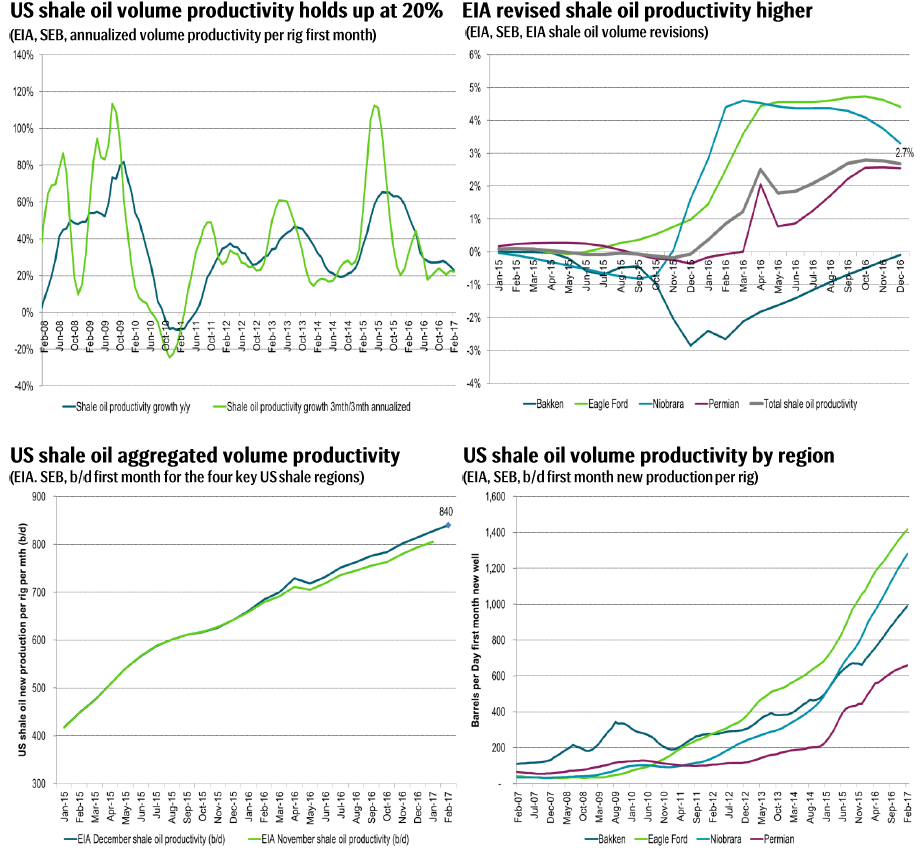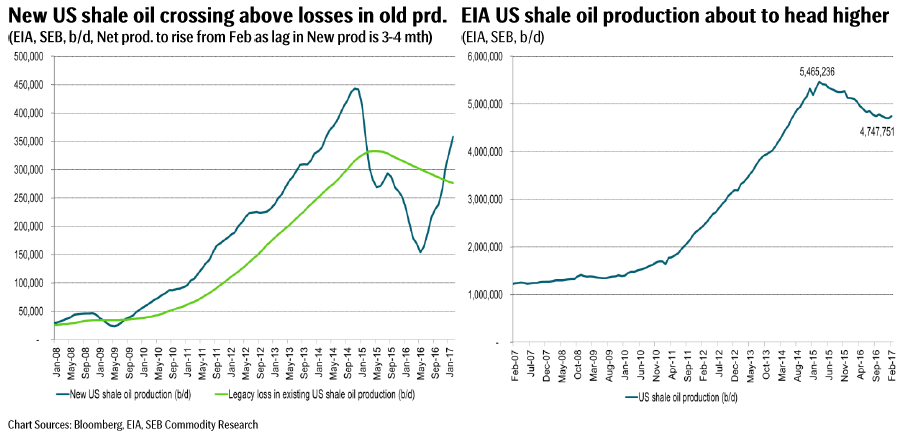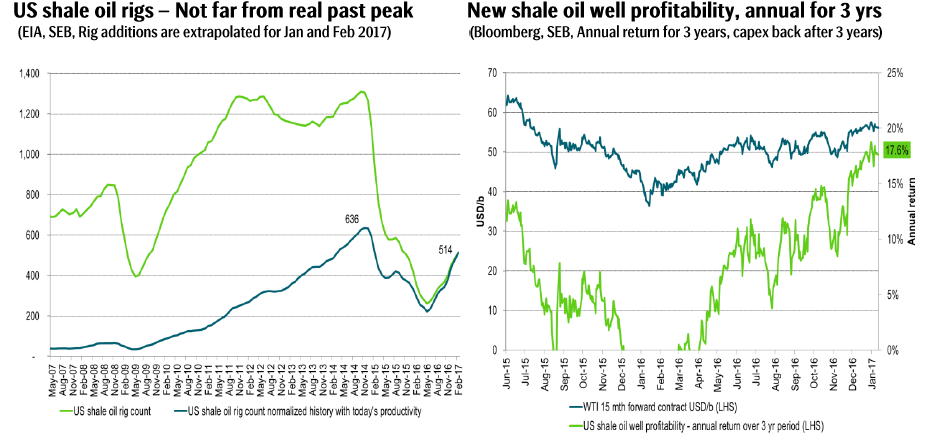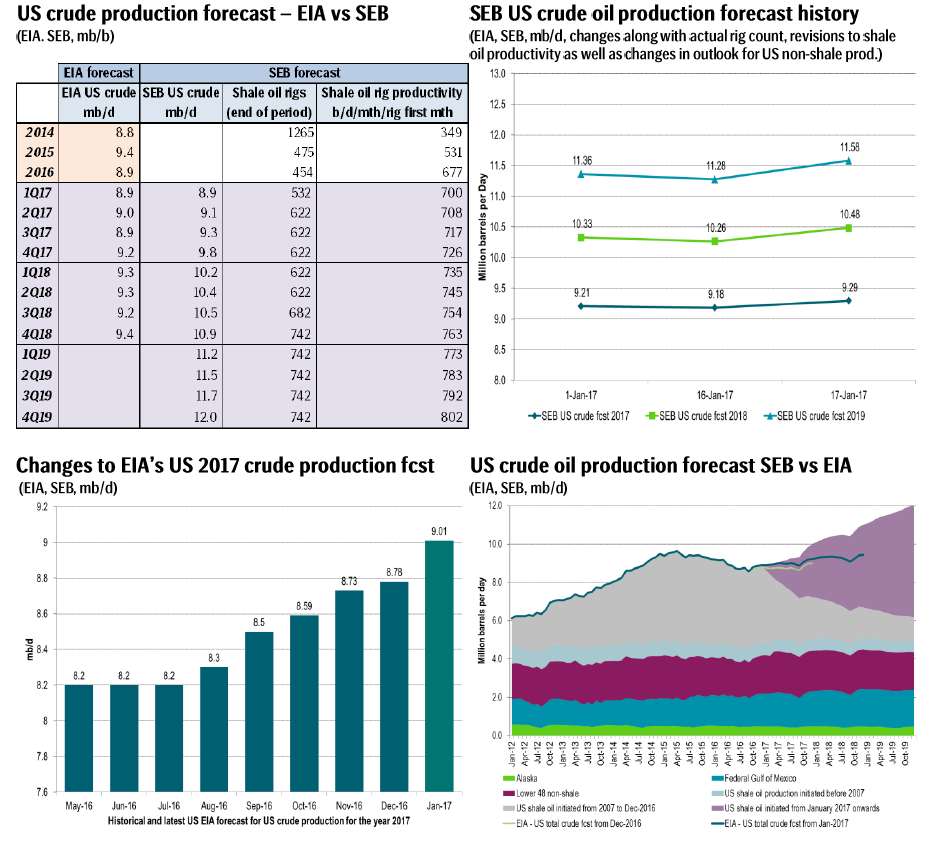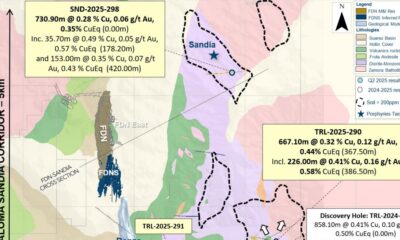Analys
US shale oil update – More rigs, higher productivity and net production about to break higher

 Yesterday the US EIA released its monthly Drilling Productivity report. It adjusted both volume productivity and rigs higher. Volume productivity continues to run at an annualized pace of 20% on a measure of 1mth/1mth, 3mth/3mth as well as y/y. These adjustments lead us to revise our US crude oil production forecast higher by between 100 to 300 kb/d (see below). What also became clear is that net US shale oil production is likely about to rise upwards in more or less a straight line as newly initiated production is now just about to break above losses in existing and previously initiated shale oil production.
Yesterday the US EIA released its monthly Drilling Productivity report. It adjusted both volume productivity and rigs higher. Volume productivity continues to run at an annualized pace of 20% on a measure of 1mth/1mth, 3mth/3mth as well as y/y. These adjustments lead us to revise our US crude oil production forecast higher by between 100 to 300 kb/d (see below). What also became clear is that net US shale oil production is likely about to rise upwards in more or less a straight line as newly initiated production is now just about to break above losses in existing and previously initiated shale oil production.
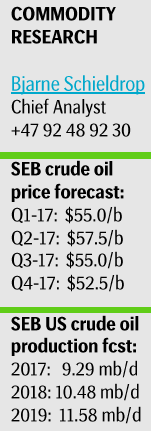 The US EIA yesterday released its monthly Drilling productivity report. It adjusted both historical and current US shale oil drilling higher with current productivity up by 2.7%. The annualized mth/mth volume productivity growth was still close to a 20% pa rate. This is higher than our assumed 5% pa from here to end of 2019. Together it lifted the volume productivity in our US shale oil production model up by 4.5% for the forecast period to December 2019. The shale oil rig count for December also came in at 454 rigs which were 10 rigs higher than we had in our model.
The US EIA yesterday released its monthly Drilling productivity report. It adjusted both historical and current US shale oil drilling higher with current productivity up by 2.7%. The annualized mth/mth volume productivity growth was still close to a 20% pa rate. This is higher than our assumed 5% pa from here to end of 2019. Together it lifted the volume productivity in our US shale oil production model up by 4.5% for the forecast period to December 2019. The shale oil rig count for December also came in at 454 rigs which were 10 rigs higher than we had in our model.
The higher productivity and rig count lifted our total US crude oil production forecast as follows:
2017: 9.29 mb/d (+109 kb/d)
2018: 10.48 mb/d (+221 kb/d)
2019: 11.58 mb/d (+303 kb/d)
Our forecast for US crude oil production will naturally be changing along with constant updates in actual rig counts versus projected once as well as revisions to volume productivity.
Besides the still continued solid 20% pa rise in volume productivity what also became very clear from the report is that US shale oil production is on the verge of breaking higher. When US shale oil production peaked in Mar 2015 at 5.46 mb/d it started to head downwards as if the line had been broken off. It was no soft turnaround. The turnaround was abrupt as new production each month broke below the running losses in already existing US shale oil production. To some degree this is now likely to happen in reverse. As shown in the graph below: “New US shale oil crossing above losses in old prd.”, the rise in newly initiated US shale oil production is now about to break straight up through the level of gradually declining legacy losses. As such the net increase in US shale oil production which has headed downwards in a pretty straight line since Mar 2015 is now likely going to head upwards in a pretty straight line instead.
If we extrapolate monthly rig additions seen this autumn (about +30 rigs per month) for January and February we’ll have a US shale oil rig count standing at 514 rigs at the end of February. If we then productivity adjust the historical rig count we see that the rig count at the end of February this year will only be 122 rigs shy of the prior peak of 636 rigs (in real terms versus today’s rig productivity).
Selected Graphs
Analys
OPEC+ in a process of retaking market share

Oil prices are likely to fall for a fourth straight year as OPEC+ unwinds cuts and retakes market share. We expect Brent crude to average USD 55/b in Q4/25 before OPEC+ steps in to stabilise the market into 2026. Surplus, stock building, oil prices are under pressure with OPEC+ calling the shots as to how rough it wants to play it. We see natural gas prices following parity with oil (except for seasonality) until LNG surplus arrives in late 2026/early 2027.

Oil market: Q4/25 and 2026 will be all about how OPEC+ chooses to play it
OPEC+ is in a process of unwinding voluntary cuts by a sub-group of the members and taking back market share. But the process looks set to be different from 2014-16, as the group doesn’t look likely to blindly lift production to take back market share. The group has stated very explicitly that it can just as well cut production as increase it ahead. While the oil price is unlikely to drop as violently and lasting as in 2014-16, it will likely fall further before the group steps in with fresh cuts to stabilise the price. We expect Brent to fall to USD 55/b in Q4/25 before the group steps in with fresh cuts at the end of the year.

Natural gas market: Winter risk ahead, yet LNG balance to loosen from 2026
The global gas market entered 2025 in a fragile state of balance. European reliance on LNG remains high, with Russian pipeline flows limited to Turkey and Russian LNG constrained by sanctions. Planned NCS maintenance in late summer could trim exports by up to 1.3 TWh/day, pressuring EU storage ahead of winter. Meanwhile, NE Asia accounts for more than 50% of global LNG demand, with China alone nearing a 20% share (~80 mt in 2024). US shale gas production has likely peaked after reaching 104.8 bcf/d, even as LNG export capacity expands rapidly, tightening the US balance. Global supply additions are limited until late 2026, when major US, Qatari and Canadian projects are due to start up. Until then, we expect TTF to average EUR 38/MWh through 2025, before easing as the new supply wave likely arrives in late 2026 and then in 2027.
Analys
Manufacturing PMIs ticking higher lends support to both copper and oil

Price action contained withing USD 2/b last week. Likely muted today as well with US closed. The Brent November contract is the new front-month contract as of today. It traded in a range of USD 66.37-68.49/b and closed the week up a mere 0.4% at USD 67.48/b. US oil inventory data didn’t make much of an impact on the Brent price last week as it is totally normal for US crude stocks to decline 2.4 mb/d this time of year as data showed. This morning Brent is up a meager 0.5% to USD 67.8/b. It is US Labor day today with US markets closed. Today’s price action is likely going to be muted due to that.

Improving manufacturing readings. China’s manufacturing PMI for August came in at 49.4 versus 49.3 for July. A marginal improvement. The total PMI index ticked up to 50.5 from 50.2 with non-manufacturing also helping it higher. The HCOB Eurozone manufacturing PMI was a disastrous 45.1 last December, but has since then been on a one-way street upwards to its current 50.5 for August. The S&P US manufacturing index jumped to 53.3 in August which was the highest since 2022 (US ISM manufacturing tomorrow). India manufacturing PMI rose further and to 59.3 for August which is the highest since at least 2022.
Are we in for global manufacturing expansion? Would help to explain copper at 10k and resilient oil. JPMorgan global manufacturing index for August is due tomorrow. It was 49.7 in July and has been below the 50-line since February. Looking at the above it looks like a good chance for moving into positive territory for global manufacturing. A copper price of USD 9935/ton, sniffing at the 10k line could be a reflection of that. An oil price holding up fairly well at close to USD 68/b despite the fact that oil balances for Q4-25 and 2026 looks bloated could be another reflection that global manufacturing may be accelerating.
US manufacturing PMI by S&P rose to 53.3 in August. It was published on 21 August, so not at all newly released. But the US ISM manufacturing PMI is due tomorrow and has the potential to follow suite with a strong manufacturing reading.
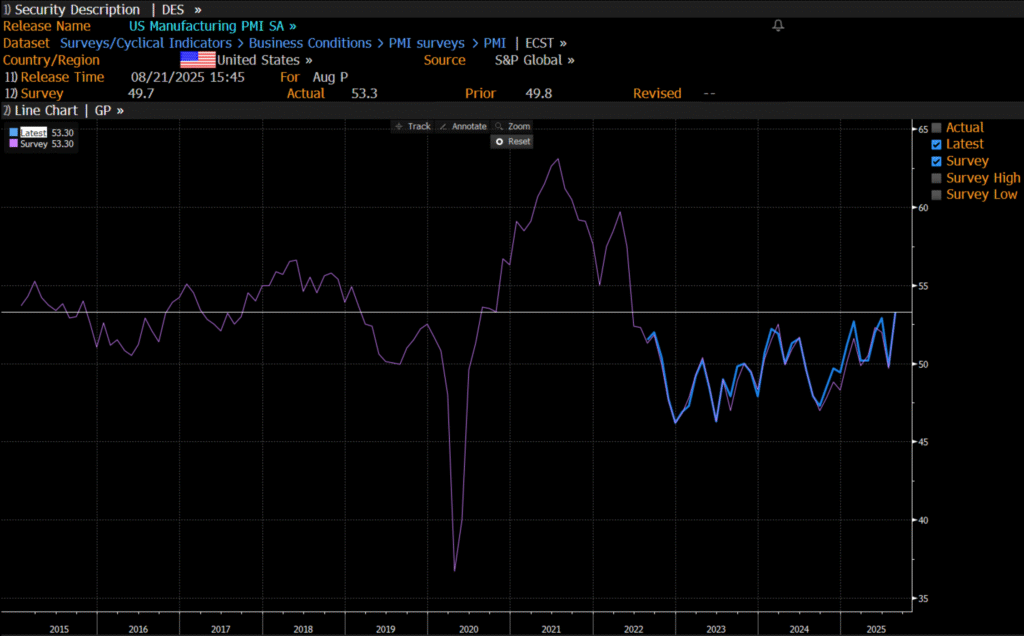
Analys
Crude stocks fall again – diesel tightness persists

U.S. commercial crude inventories posted another draw last week, falling by 2.4 million barrels to 418.3 million barrels, according to the latest DOE report. Inventories are now 6% below the five-year seasonal average, underlining a persistently tight supply picture as we move into the post-peak demand season.

While the draw was smaller than last week’s 6 million barrel decline, the trend remains consistent with seasonal patterns. Current inventories are still well below the 2015–2022 average of around 449 million barrels.
Gasoline inventories dropped by 1.2 million barrels and are now close to the five-year average. The breakdown showed a modest increase in finished gasoline offset by a decline in blending components – hinting at steady end-user demand.
Diesel inventories saw yet another sharp move, falling by 1.8 million barrels. Stocks are now 15% below the five-year average, pointing to sustained tightness in middle distillates. In fact, diesel remains the most undersupplied segment, with current inventory levels at the very low end of the historical range (see page 3 attached).
Total commercial petroleum inventories – including crude and products but excluding the SPR – fell by 4.4 million barrels on the week, bringing total inventories to approximately 1,259 million barrels. Despite rising refinery utilization at 94.6%, the broader inventory complex remains structurally tight.
On the demand side, the DOE’s ‘products supplied’ metric – a proxy for implied consumption – stayed strong. Total product demand averaged 21.2 million barrels per day over the last four weeks, up 2.5% YoY. Diesel and jet fuel were the standouts, up 7.7% and 1.7%, respectively, while gasoline demand softened slightly, down 1.1% YoY. The figures reflect a still-solid late-summer demand environment, particularly in industrial and freight-related sectors.


-

 Nyheter4 veckor sedan
Nyheter4 veckor sedanOmgående mångmiljardfiasko för Equinors satsning på Ørsted och vindkraft
-

 Nyheter2 veckor sedan
Nyheter2 veckor sedanMeta bygger ett AI-datacenter på 5 GW och 2,25 GW gaskraftverk
-

 Nyheter4 veckor sedan
Nyheter4 veckor sedanGuld stiger till över 3500 USD på osäkerhet i världen
-

 Analys4 veckor sedan
Analys4 veckor sedanWhat OPEC+ is doing, what it is saying and what we are hearing
-

 Nyheter2 veckor sedan
Nyheter2 veckor sedanAker BP gör ett av Norges största oljefynd på ett decennium, stärker resurserna i Yggdrasilområdet
-

 Nyheter4 veckor sedan
Nyheter4 veckor sedanLyten, tillverkare av litium-svavelbatterier, tar över Northvolts tillgångar i Sverige och Tyskland
-

 Analys2 veckor sedan
Analys2 veckor sedanBrent sideways on sanctions and peace talks
-

 Nyheter3 veckor sedan
Nyheter3 veckor sedanEtt samtal om koppar, kaffe och spannmål


